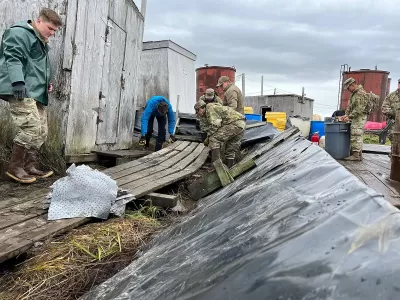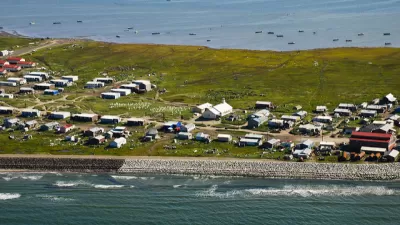Increasingly threatened by the impacts of climate change and extreme weather, many Native Alaskan and other indigenous communities will have to relocate—and soon.

An article by Emily Schwing in High Country News describes the challenges facing Native villages in Alaska and other parts of the United States, where “Melting permafrost, increasing wildfire threats, severe drought and other climate-change related phenomena mean dozens, perhaps hundreds, of small, predominantly Indigenous communities across the nation may need to move.”
The Alaskan village of Newtok only had a nomadic population until the mid 20th century, when federal authorities told Yup’ik residents that they had to settle permanently to access federally funded schools. “But the land in Newtok has never been all that stable: Since the 1950s, the banks of the Ninglick River have been eroding at rates as high as 70 feet per year.” As Schwing notes, the community has been painfully aware of this. “For more than two decades, Newtok has been trying to plan for a full relocation.”
The federal government has started awarding grants to communities needing to relocate. But with a total cost estimated at $120 million or more for the Newtok relocation, how far can a $25 million grant, awarded by the federal government through the Bipartisan Infrastructure Law, go?
The village faces with a slew of costs that won’t be covered by the federal grant. Patrick LeMay, the Newtok relocation project manager, estimates a need of $8 million for additional housing, plus $60 million for a school, $2.3 million for a health clinic, and other infrastructure needs. As the impact of climate change intensifies, more communities will need assistance.
FULL STORY: How far can $25 million go to relocate a community that’s disappearing into Alaska’s melting permafrost?

Maui's Vacation Rental Debate Turns Ugly
Verbal attacks, misinformation campaigns and fistfights plague a high-stakes debate to convert thousands of vacation rentals into long-term housing.

Planetizen Federal Action Tracker
A weekly monitor of how Trump’s orders and actions are impacting planners and planning in America.

In Urban Planning, AI Prompting Could be the New Design Thinking
Creativity has long been key to great urban design. What if we see AI as our new creative partner?

Cal Fire Chatbot Fails to Answer Basic Questions
An AI chatbot designed to provide information about wildfires can’t answer questions about evacuation orders, among other problems.

What Happens if Trump Kills Section 8?
The Trump admin aims to slash federal rental aid by nearly half and shift distribution to states. Experts warn this could spike homelessness and destabilize communities nationwide.

Sean Duffy Targets Rainbow Crosswalks in Road Safety Efforts
Despite evidence that colorful crosswalks actually improve intersection safety — and the lack of almost any crosswalks at all on the nation’s most dangerous arterial roads — U.S. Transportation Secretary Duffy is calling on states to remove them.
Urban Design for Planners 1: Software Tools
This six-course series explores essential urban design concepts using open source software and equips planners with the tools they need to participate fully in the urban design process.
Planning for Universal Design
Learn the tools for implementing Universal Design in planning regulations.
Appalachian Highlands Housing Partners
Gallatin County Department of Planning & Community Development
Heyer Gruel & Associates PA
Mpact (founded as Rail~Volution)
City of Camden Redevelopment Agency
City of Astoria
City of Portland
City of Laramie





























